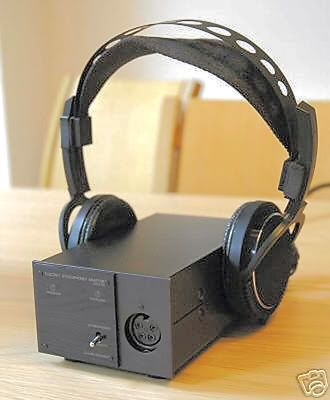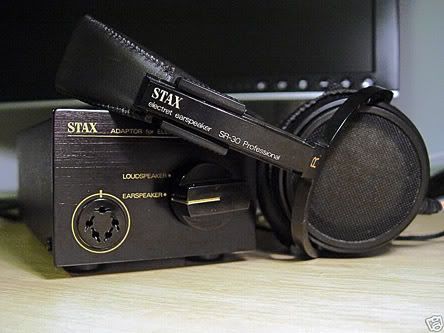I'm listening to the underrated Rachael Yamagata's
Happenstance album fed into the
XR25 optically from my faithful little Sony
D-EJ715.
I should also say that being used to things like sixth-order ported speaker alignments where the woofer is overdamped, then brought back up with bass EQ, I don't judge a 'phone merely on its performance on the level-- if a 'phone can straighten out its response curve when fed simple shelving/tilting EQ without breaking up, I give it that EQ and judge its sound at that point.
It's also worth noting that the ATH-6/7/8 all have a driver that's approximately 50mm in diameter-- small for an electrostat.
The first thing I notice is the 6 is about 20 steps on the XR25's volume control less efficient than the Lambda Pro. If each step is 1 or 2dB, that's 10 or 20dB, a pretty big difference. Tricky to switch from the Stax to the A-T to make comparisons. The 6 has a typical '70s 'phone response curve, a "frownie", requiring a "smiley" on a graphic EQ to even it out. The top of the frown is at that magic Sennheiser frequency, about 2kHz, so they sound a little like the old HD 414, to which they're much more closely related timewise than to us and our computer-designed wonderphones.
However, the 6 responds pretty well to simple Baxandall-type tone controls, such as the ones found on the XR25. The 6's little transformer box doesn't really want 10dB of bass boost, but it'll take it, and with an equal amount of treble laid on, the sound un-frowns to give you a tight, forward, punchy sound that's still not talking too loud below say
50 Hz or above
12kHz, which looks bad, but turns out to be perfectly satisfactory until you switch back to the Lambdas, which have what sounds like an octave more to offer on both ends and a liquid smoothness to boot. The Lambda is a whole 'nother world, and it should be, since it cost [me] 7 times as much.
When EQ'd, the 6 is reminiscent of the AKG K501, which gives you an idea how far dynamics have come, but the 6 is still superior in the overall tightness of its sound, and of course the K501 was twice the cost on closeout.
By the way, that peak around 2k turns into a little hillock that remains even after you apply EQ. You can get an idea of what some extra acoustic resistance behind the drivers would do to the sound by slowly closing your hands around the backs of the open driver cups. Does it sound better to you that way? It does to me, but soundstage would, of course, suffer.
An entertaining 'phone, though not a convincing demonstrator of electrostatic sound for today's listeners. Was it better than most of the similarly-priced competition in 1978, when both it and Rachael Yamagata were introduced to the world? You betcha. Is it worth 50 bucks? Ehh, call it 40.
EDIT FO THE RELIEF OF THE PAIN OF PIXLESSNESS: Conspiratorially enough, the A-Ts of this period look spookily like the slightly later Stax SR-30 (US market designation) electrets, and more or less exactly like one another-- without the graphics printed on the side, you'd be hard-pressed to tell a 6 from a 7 from an 8 from a 70 from an 80. The photo below left is of the later ATH-70, but it looks exactly like the 6. At lower right is the Stax SR-30 Pro, which if offered at a reasonable price is a better buy than the A-T, if only because it's compatible with all present-day Stax amps and energisers (aka transformer boxen). More bass, too, but the cups are deeper and less elegant.
.






